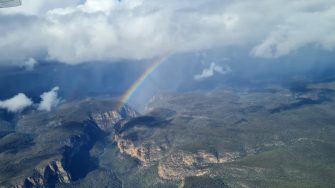
Date: Friday, October 15, 2021
Project: Eastern Australian Waterbird Survey
Observers: Richard Kingsford & John Porter
Pilot: James Barkell
We left Griffith under overcast conditions with showers coming across from the west. At least there wasn’t much wind. We headed first for Lake Brewster, on the Lachlan River. This massive lake was made into what is called a re-regulating storage. This means that water that comes down the Lachlan River is shunted into the lake, stored for later use.
Lake Brewster.
It's a good habitat for waterbirds, largely because significant parts of it are shallow. This leaves lots of feeding areas for different waterbird species. The aquatic vegetation grows well in the bottom of the lake. There were hundreds of coot, black swans and grey teal as well as various ibis and hundreds of terms.
There was also a colony of pelicans breeding on some constructed islands in the western part of the lake, probably a couple of hundred nests or more. Once we're done with our two circuits of Lake Brewster, we also flew down the middle of the lake where there were very few birds.
We then headed north east towards Lake Cargellico. This lake is again used to store water from the Lachlan River but also provides water views to the nearby town of Lake Cargellico. There wasn't much happening on the waterbird front here. Just a few pelicans, pied cormorants and the odd white ibis. There were a couple of lakes north of the main lake, but they didn't have much on them either.
Lake Cowal
Then it was off to Lake Cowal. We started on the edge of the lake, near the gold mine. The lake was much fuller than last year. And as with most places we've surveyed there were fewer waterbirds because there is so much water around. Lake Cowal is still a very impressive wetland; it is large with many diverse habitats. And so it's got lots of diversity of habitats and many different waterbird species, including the herons, the ibis, and many of the ducks. There were also swans, coot, terns and various small wading birds.
It was great to see that they were also quite a few birds nesting, including several thousand straw-necked Ibis nesting and, excitingly, there were a few magpie geese nesting. They were all in the vegetation islands in the middle of the lake.
Vegetation communities for nesting waterbirds in the middle of Lake Cowal.
The story around magpie geese is a really good news story for the wetlands and waterbirds in the Murray-Darling Basin. Numbers seem to be increasing over the years. And establishing strongholds in places like Lake Cowal and the Macquarie Marshes.
After we had done the two circuits on the very large Lake Cowal, we headed to Dubbo to refuel. The weather continued to be inclement, with showers scudding in from the west. We still had the bits of survey, east of Dubbo, that we hadn't been able to do a couple of days ago when we left Sydney.
Afterwards we headed along the Maquarie River. Luckily there was enough of a gap in the weather for us to fly down a significant section of the river, with its flocks of wood ducks and black ducks.
Surveying along the Macquarie RiverSurveying along the Macquarie River.
We then headed past the extensive solar farm just north of Wellington.
Then on to the northern arm of Burrendong Dam, with the weather giving us a break. The dam was almost full, very different from the previous few years.
As expected, this dam had very few waterbirds, although we saw a sea eagle. The fullness of the dam means if there is more rain, there's a wonderful opportunity for the dam to spill. If the water can make it to the Macquarie Marshes it will really set things off. But we need the La Niña to extend and deliver the much needed water for the marshes.
Flying over the Blue Mountains back to Sydney to finish off this leg of the survey.
By Richard Kingsford
